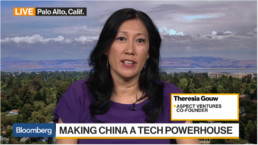RSA Conference: Innovation & Cybersecurity Industry
Theresia Gouw talks security with RSA Conference's Britta Glade. Here’s something to ponder: In an alternate universe, where would cybersecurity be today without the continuous pursuit of innovation? While we can only guess, one thing is pretty certain. Cyberattackers would be a lot happier in that universe than they are here. In this episode, we take a look at multiple aspects of industry growth—from revenue and investments to tech advancements and opportunities.
Some of the topics we cover include:
•What investment strategies are VCs employing in 2018, and how do they differ from previous years?
•What criteria should buyers consider in choosing startups to add to their security portfolios?
•Based on where the industry is headed, what new and exciting developments can we expect at the RSAC 2018 Early Stage Expo?
(Listen on RSAConference)
Making China Into a Tech Powerhouse
Aspect Ventures co-founder Theresia Gouw discusses the impact of a trade war on China's tech industry. She speaks on "Bloomberg Daybreak: Asia."
(Watch on Bloomberg)
Theresia Gouw named to 2018 Midas List
Aspect's Theresia Gouw has been named to the 2018 Forbes Midas List.
(Read on Forbes)
Seven-time Midas lister Theresia Gouw focuses on software and security technology at Aspect Ventures, the firm she cofounded in 2014 with Jennifer Fonstad. Prior to Aspect, Gouw was a general partner for 15 years at Accel. Her mission with Fonstad: bring collaboration back to Series A companies and bridge the gap between angel investors and larger multi-stage VC firms. In October 2017, Gouw scored an exit through the initial public offering of cybersecurity company ForeScout, which carries a market cap of more than $1 billion and is Gouw's fourth investment to reach the IPO milestone. (Gouw led ForeScout's Series A and has served on the board since.) She invested early in real estate search engine Trulia (IPO 2012) and more recently Cato Networks, which offers next-generation security services on demand, as well as Exabeam, a leader in user behavior analytics for cybersecurity. Gouw is also an investor in The Muse, a career advice website for millennials. A first-generation immigrant and engineer by training, Gouw is a passionate supporter of causes that support immigration and STEM education, including DonorsChoose.org. In 2016 she gave a TEDx talk about diversity and innovation, "How Entrepreneurs Can Help the American Dream Get Its Mojo Back." She's one of four Midas list partner members of All Raise, the women investor group profiled in Forbes' Midas cover story in April 2018.
How Melinda Gates Is Tackling Tech’s Gender Problem
Over the last few decades, Melinda Gates’ philanthropy has taken her to all corners of the globe. But recently she’s come to focus on an issue much closer to home: a dearth of women in tech. This week on Decrypted, Melinda Gates sits down with Bloomberg Technology’s Emily Chang to talk about her decision to back a venture capital firm run by two women, and what she hopes to achieve from that investment.
(Listen to the podcast on Decrypted)
The View from Silicon Valley
Mobile-only bank Chime isn’t your parents’ or grandparents’ bank.
The San Francisco-based start-up is gaining 100,000 accounts a month – it’s at roughly 900,000 – at a time when most large banks are struggling to attract millennials. Like other tech companies such as Amazon.com (AMZN), rumored to be considering a foray into checking accounts, Chime sees an opportunity in financial services amid a shifting customer base and widespread dissatisfaction with big bank services.
(Read on Barron's)
“The days of getting all your financial services from one bank brand are ending,” says Chime Chief Executive Officer Chris Britt. “Our customers tend to be younger, rely on their smartphones and hate big banks.”
Indeed, 57% of millennials said they would change their bank relationship for a better technology platform solution, according to Deloitte. One reason why: Americans pay $15 billion annually in overdraft fees alone.
Chime is targeting those in their late 20s and early 30s with a low-fee checking and savings account, a mobile app that allows for automated savings and real-time notifications, and a policy of no monthly fees, hidden fees or overdraft charges. It makes money through a 1.5% fee of Visa-related transactions by its customers.
“Wells Fargo (WFC) reported $1.246 billion of service charges on deposit accounts in its last quarter,” Britt says. “That’s great advertising for us.”
Chime has benefitted from word-of-mouth referrals from customers, often on social media platforms such as Instagram, says Britt. Many are defecting from monolithic banks who crave lower costs and a simplified experience, he says.
The trend toward tech-centric, mobile banks has already started in Europe, where relaxed regulations have led to so-called “challenger” banks such as N26 in Germany, Monzo in Italy and Revolut in the UK, says Britt. —Jon Swartz
Companies Are Seeing How Vulnerable They Are to Hacks
George Kurtz, Chris Roberts and Theresia Gouw talk about the state of security and what comes next
It’s obvious that cybersecurity continues to be one of the biggest priorities facing government and industry. The number of hacks is rising, as is their scale—with the threat of even greater thefts and disruptions seeming ever more likely. The character of the attackers is changing, too, as the line between state-sponsored hackers and independent criminals gets ever hazier.
To examine the topic, and how companies should deal with it, The Wall Street Journal’s editor in chief, Gerard Baker, spoke with Theresia Gouw, founding...
(Read the full story on WSJ)
Entrepreneurs Are The Key To Keeping California's Renewables Market Booming
When it comes to renewable energy, California is doing great. The state is ahead of schedule for meeting its goal of 50% of all power coming from renewable sources by 2030. Thanks to abundant sunshine and plenty of wind in places like the desert around Palm Springs, a full 68% of renewable energy is coming from solar and wind farms.
(Read on Forbes)
But is it possible to have too much of a good thing?
While California’s renewable energy boom is good for the environment, it’s not always financially efficient. That’s because on many days, California is actually producing more renewable energy than residents are using. On several occasions, utilities have had to pay surrounding states to take the excess energy off of their hands.
This is a tricky but not insurmountable problem. Entrepreneurs are well positioned to create products and technologies to help the state better manage its energy supply and demand. But to see the potential for this new industry, it’s important to understand why California has been forced to dump excess electricity in the first place.
Power grids work on a delicate balance of supply and demand. With fossil-fuel-powered plants, that’s not really an issue. When demand increases, these plants can easily power up to produce more electricity. When demand drops, they can temporarily slow generation.
But renewables work differently. When the sun is shining, solar panels convert it into power. When the wind blows, operators can’t just stop wind turbines from spinning. That can result in excess power flowing into the grid. And if supply outstrips demand, there’s a significant risk of blackouts as transmission lines get overwhelmed. Instead, utilities have to find ways to get rid of that excess electricity, too often by paying other states to take it.
This imbalance is a result of government and industry focusing more on generation than energy management. That’s why management is the next big market.
For example, a critical solution to the grid problem is batteries. Batteries in homes could store solar power to help people become energy self-sufficient. (Currently people with solar panels can draw energy from them only when the sun shines — unless they own a storage system like the Tesla Powerwall.) Batteries throughout the grid could store and release renewable energy to help keep the grid in balance.
Another way to manage energy use is through smart devices in the home. Power companies could alert people to use energy when demand is low and to curtail use when demand is high. The app OhmConnect already offers a service that pays people to reduce their energy use when demand is high (the company profits from utility companies that pay to avoid firing up additional power plants).
Expect to see more entrepreneurial innovation in this space — especially coming from San Diego, where the San Diego Regional Energy Innovation Network is working with startups on creative solutions to California’s energy problems.
Southern California Edison also has an interesting plan to help manage energy use through a combination of energy storage, more electric cars on the road and electrification of home space and water heaters. The idea is that by tackling the problem from a holistic point of view, every aspect of renewable power — from generation to use — could become more efficient and prevent future supply-and-demand imbalances. This kind of plan could open the door for many entrepreneurs.
In the first quarter of 2017, utilities had to curtail solar and wind production by 3% to compensate for supply-and-demand imbalances. With a little encouragement and some California ingenuity, entrepreneurs can help keep the state moving toward its goals while building new businesses.
Venture capitalists are investing an ‘unprecedented’ amount of money in tech — but there’s a catch
Aspect Ventures co-founder Jennifer Fonstad says the money is frequently not going to the entrepreneurs who need it most.
When Jennifer Fonstad became a venture capitalist, joining Draper Fisher Jurvetson in 1997, only 10 percent of the companies funded there had prior investors. And back then, she says, there was really just one angel investor: Ron Conway.
“Cycle forward 20 years and you have incubators, accelerators, seed funds, angel networks, micro-funds,” Fonstad said on the latest episode of Recode Decode, hosted by Kara Swisher. “The amount of capital available to get a company started is unprecedented.”
(Read and listen on Recode)
But just because there’s a lot of money floating around doesn’t mean that it’s spread evenly. Fonstad said most VC money is still directed at nascent companies, or successful ones that are scaling up; not enough is being pledged to help companies cross the “chasm” in which so many startups fail, which is one of the ills Aspect is hoping to address.
“That’s still an area where it’s an art, not a science, understanding the patterns of what’s likely to work and not, and how companies navigate that,” she said. “It’s still an area that is, I think, too high-risk for the growth folks. And the seed folks typically try to get all their ownership early on so they don’t want or need to take on that additional risk at that stage.”
On the new podcast, Fonstad also talked about how her job as a venture capitalist is changing now that startups can potentially get money from so many more places, including initial coin offerings. The simple-but-true reality is that VC firms have to provide more than just cash.
“We’re not ‘dumb money’ when you find talented people to help you build a business,” she said. “Entrepreneurs take incredible risks and put an incredible amount of their heart, soul energy and time into building a company, but it still takes a village to build successful companies.”
30 women in venture capital to watch in 2018
In 2017, the presence of women in venture capital made feeble progress at the country's top firms.
Union Square Ventures and First Round Capital were among two firms last year to take on their first female general partners.
And more and more women are founding female-led firms with an express interest in investing in female-founded startups, in order to break up tech's gender discrepancy.
We've rounded up a list of women across the US who are sourcing noteworthy deals, founding female-led firms, cultivating interest in female-founded startups, and making strides in venture capital.
(See list on Business Insider)
Venture Capital Is Broken. These Women Are Trying to Fix It
Female CEOs get a dismal 2.7 percent of all venture capital, the fuel for building fast-growth companies. Now armies of women are ditching Sand Hill Road and creating their own funding universe. (Photo Credit: Hanna Barczyk)
(Read on Inc)
All great revolutions begin with alcohol. That seems to be the consensus at 9 in the morning on a sunny Friday in August, when 100 women board Dandeana, a three-level, 110-foot yacht about to set sail from Los Angeles's Marina del Rey. Muffins and fruit are mostly ignored as a bartender pours mimosas for the boat's guests, a diverse collection of women that includes attorneys, business coaches, a nurse, a documentary filmmaker, and a grandmother-granddaughter team. In sunglasses and mostly low heels (this is a boat, after all), these women will spend the next three hours plotting to overthrow the boys' club that rules the Silicon Valley venture capital scene.
This particular coup is being hosted by Vicki Saunders, a ridiculously energetic five-time entrepreneur with a blond bob and oversize black glasses, who is also the founder of SheEO. SheEO is a startup that wants to use low-interest debt to fund the growth of women-led companies. Saunders's premise is that masses of women could become the major source of funding for the next generation of female entrepreneurs. Her math works like this: If 1,000 women in a city each invest $1,000, that's $1 million available for lending to 10 female-run companies. Ideally, she'll recruit women from 1,000 cities, participants will re-up every year, and they'll put the money back in as the loans are repaid. Saunders's big-picture calculation: a billion dollars going to 10,000 female entrepreneurs every year, in perpetuity.
The mimosa-sipping guests are intrigued. Chelsea Galicia, a 33-year-old nonprofit executive director in a black V-neck jumpsuit, likes the fact that SheEO might give her a chance to back socially responsible companies. "I have a very hard time investing in the stock market because those companies are ruining the environment," she says. Tara McColeman, a nutritionist, says when she was married and applied for a new credit card, her husband was automatically designated the primary cardholder. "We live in a patriarchal society--it's just that way," she says. "I think women do need to band together more."
That the vast majority of these women have never before invested in startups, says Saunders, doesn't hurt SheEO's premise--it's precisely the point. After years of working with entrepreneurs at accelerators where the goal was always to build a billion-dollar company, Saunders noticed that fewer than 20 percent of accepted participants were women. Yet, she says, "we get to profitability faster than men and are more capital efficient." Saunders, who spent much of her career building youth-related companies, had long resisted starting something gender-based. But by 2013, she felt she had no choice. "Everything is broken," she says, referring to women's fundraising options. "Why do we want investors who know lots about things that don't work for women?"
To see how broken it is, look at the statistics. While women start companies at twice the rate of men, female-founded companies get only 13 percent of the total angel financing available. According to a study by First Round Capital, companies with a woman on the founding team outperform their all-male peers by 63 percent. But when it comes to venture capital--often the speediest route to building a fast-growth company--women simply aren't getting funded. Female CEOs get only 2.7 percent of all venture funding, while women of color get virtually none: 0.2 percent.
The women who are committed to female entrepreneurs have given up waiting for the venture capital industry to change. In 1999, the portion of venture capital deals that went to a startup with a woman on the executive team was just 5 percent. It's taken nearly 20 years to increase that amount to 18 percent. It's no better when you look at the profession itself. In 1999, 10 percent of venture capitalists were women; today, their number has sunk to just 6 percent.
The idea that women should be funding other women is hardly new. In 2005, a group of mostly Wall Street women started Golden Seeds, declaring that it would make angel investments only in female-led companies. Dozens of other early-stage investment groups have since followed its pioneering lead. Aspect Ventures, for example, was launched by two women, and co-founder Theresia Gouw says the firm sees more female-led deals as a result. Aspect's portfolio is about 40 percent women. That of Broadway Angels, one of the highest-powered gatherings of women in Silicon Valley, is roughly 50 percent.
As empowering as this seems, each of these initiatives hits the same wall: The business model doesn't scale. Each investment partner can do only so many deals and sit on only so many boards. With few female VCs to begin with, there simply aren't enough women with the experience, connections, and desire to raise their own funds.
But what has become clearer in recent years is that there is a hunger among women who've never traditionally thought of themselves as investors. According to a 2014 study by the Kauffman Foundation and Hebrew University, it turns out that when a female entrepreneur tries to raise money on Kickstarter, she is 7 percentage points more likely to be funded than a man. Women aren't showing up on crowdfunding sites to back just any kind of business--they are specifically seeking out those with female founders. While an advantage of 7 percentage points doesn't sound huge, if that shift happened in the larger female fundraising universe, the impact would be radical.
SheEO's Saunders is part of a group of women now trying to channel that desire and pipeline of cash to an even larger pool. The money is undeniably out there: Women currently control 39 percent of the country's investable assets, some $11.2 trillion. About 70 percent of the massive intergenerational wealth transfer will soon go to women, who will inherit once from their parents and again from their husbands (women in the U.S. tend to outlive men by 4.8 years). "Women control a lot of capital," says Darya Allen-Attar, co-founder of the Women Founders Network. "Men connect their capital with power," she concedes. "We don't."
Rather than grow more professional investors, Saunders and her peers are now working to train armies of novice female investors at various levels of disposable income. Forget the sophisticated gatekeepers, they say. Let's open up the gates.
Pretending to be Men
For decades, female entrepreneurs have been told that, yes, they absolutely can get funded by high-profile angels and venture capitalists. They just need to start companies that can scale, improve their pitches, and work on their confidence. For more than a decade, Sharon Vosmek, as the CEO of Astia, encouraged female founders to do just that. The organization would help entrepreneurs finesse their pitches and decks, and then connect them to investors. "Our job was to source the best deals, and venture capitalists would fund them because it was a meritocracy," she says.
But as Vosmek and others learned, it was never that simple. The industry's problems with sexism and unconscious bias have been well documented. When female founders pitched a business idea designed to solve a female problem, it was unlikely there was ever a female VC in the room. Though male VCs should be able to evaluate the merit of any early-stage company on the basis of its business plan, market research, and leadership, they would often declare ignorance and go home and ask their wives about it. Vosmek says Sand Hill Road has "a comfort zone," and if you're not in it, "they just shut down."
In 2015, Fran Dunaway experienced this firsthand while trying to get seed funding for her company, TomboyX, which makes men's-style briefs for women. "You could just see their eyes glaze over," says Dunaway, who got her business idea after discovering that typical panties weren't comfortable for women in uniform. Dunaway, who eventually raised 90 percent of her $1 million seed round from female angels, is expecting her company to take in revenue of $3 million this year.
Even when there is a female investor at the table, female entrepreneurs still often face an uphill battle. Janet Gurwitch, co-founder of Laura Mercier Cosmetics and the only female operating partner at private equity firm Castanea Partners, remembers presenting Drybar to her male partners in 2011. Drybar is a place for women to get their hair blown out relatively quickly and cheaply. Gurwitch genuinely worried that, among other things, "six of the 11 [partners] have very little hair. They're going to tell me it's a low barrier to entry." She prevailed, partly by reminding them that Starbucks was once "a little coffee shop in Seattle." Today, Drybar has nearly 70 locations and $100 million in revenue. Says Astia's Vosmek: "I don't think [early] investors are going to be, for women, classic venture firms."
Blowing Open the Gates
Right now, the alternative funding universe for women is just being constructed. If there's anyone who's qualified to help design it, it's Trish Costello, the former CEO of Kauffman Fellows, a startup-financing leadership program. She spent 10 years working to increase the range of people pursuing venture capital as a career. "What we saw was a lot of women left the business," says Costello. "Even when they were highly successful in terms of their [return], they were often not fully integrated into the leadership of the funds."
Frustrated, in 2013, Costello left Kauffman to start Portfolia. Instead of trying to convert women into career investors, she's working to persuade them to make investing a serious sideline. Rather than restrict participation to the well-connected or seriously wealthy, anyone who plunks down $10,000 in a Portfolia fund--each of which invests in six to eight female-run companies--immediately becomes a Portfolia LP (limited partner). LPs get a front-row seat to the entire funding process: They can watch the entrepreneurs pitch online, ask founders questions, and talk to the fund leads about deal terms and due diligence.
Portfolia LPs like Peggy Northrop, herself an entrepreneur, say the experience has demystified investing. "One thing I had worried about with angel investing is you have to be really, really rich," says the co-founder of PaperQuilt, a collaborative storytelling platform. "This makes it something you can plug into and learn from. You can develop some confidence."
Meanwhile, Pipeline Angels' Natalia Oberti Noguera is providing newbie female investors with an even lower barrier to entry. In 2011, the nonprofit executive founded the New York City-based outfit to increase the number of angel investors who weren't white, straight, and male. Pipeline offers training for would-be angels, and so far, about 200 women have completed it. As part of that training, each has to invest at least $5,000 in a startup.
Proof that these more democratized approaches are making a dent will depend on whether the participants ultimately go on to invest elsewhere. "We're creating our own brand of women VCs who are not anything like those you would normally create on Sand Hill Road," says Portfolia's Costello.
The $7.7 Billion Stretch Ahead
The question looming over all this: How much money will it take, really, to level the playing field for female entrepreneurs?
With current rates of funding, to reach parity across just the angel and early-stage VC markets would require about $7.7 billion. To reach parity across all stages of venture capital would require about $50 billion. By Inc.'s count, there are currently about two dozen early-stage female-focused financing efforts, representing about $100 million in funding annually.
In other words: We're not even close.
To fill that gap will require an even broader movement. Women who have their savings parked in retirement funds or who donate to charity will need to be persuaded that putting a fraction of their money in a new business is worthwhile. "Your retirement fund is allocated into companies you have no window into," says Northrop, the Portfolia LP. "You could put just 1 percent of that into a company you care about."
Astia's Vosmek says nontraditional funders are another target. One entrepreneur she worked with ended up raising money from the business wing of the Grosvenor family, which historically has been led by the Duke of Westminster. "They've been investing for 1,200 years," says Vosmek. Now she is courting philanthropists interested in world-changing ideas. "We're pointing out that early-stage investing can look a lot like philanthropy," she says.
Of course, the risk tolerance of women who've never invested before has yet to be tested. A SheEO member might not think $1,000 is a lot until a company that SheEO funds is unable to repay it. Portfolia's Costello and Astia's Vosmek are trying to manage expectations accordingly, making it clear to their investors that they aren't trying to bet on the next unicorn. Their goal is to fund companies that are successful, whatever that might mean.
Back in L.A., Dandeana is about to return to port. SheEO's Saunders won't know until late fall how many of the women aboard will join her movement. Earlier this year, a SheEO pilot in Toronto persuaded 500 women to each fork over $1,000. By September, Saunders will have hit San Francisco and Denver. Getting to 996 more cities will require many years, and many more mimosas. But when one woman on the boat approaches Saunders with a question, she's reminded why the hustle will be worth it.
"Can I write you a check right now?" she asks.











